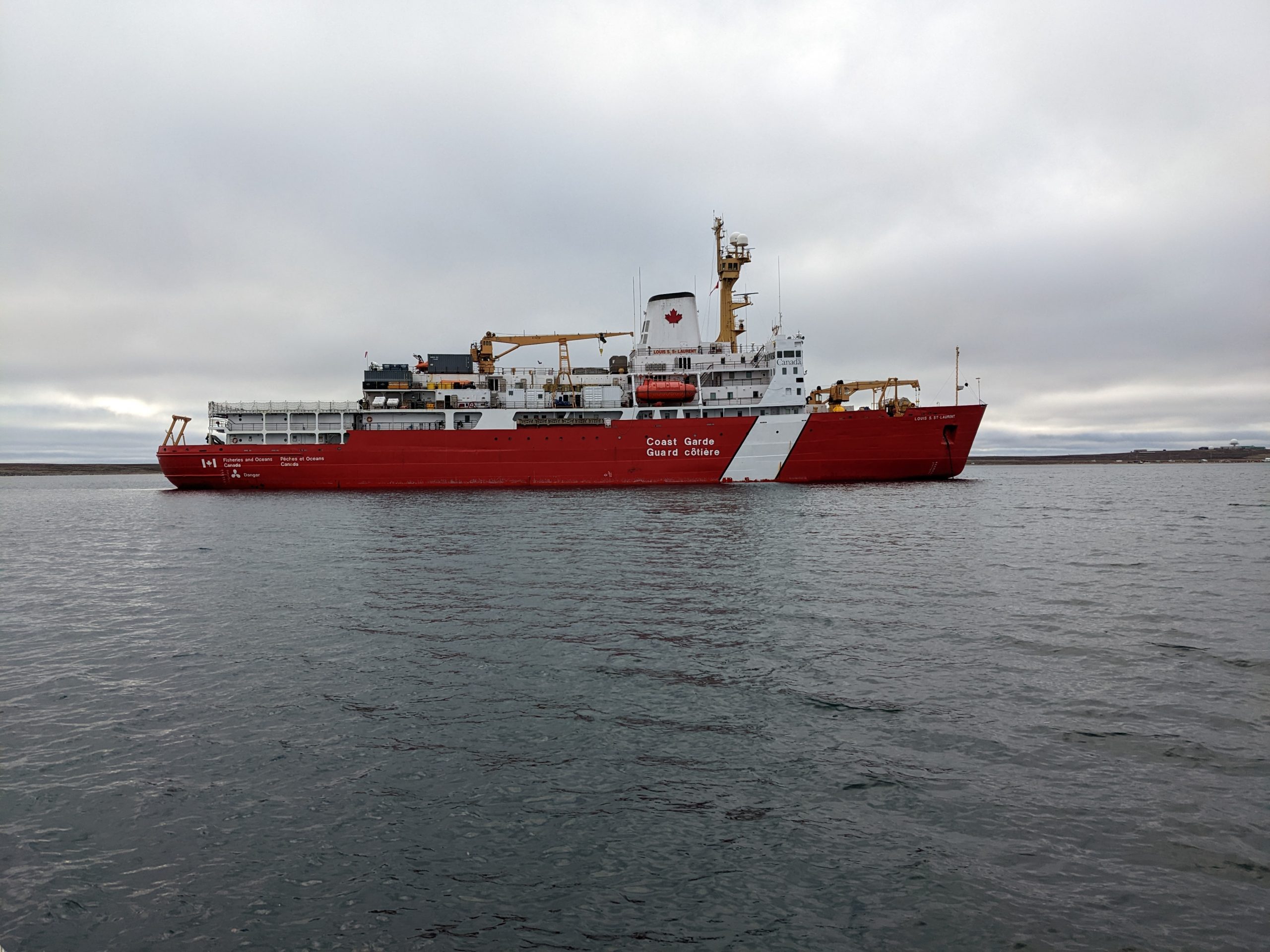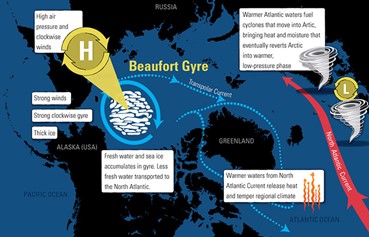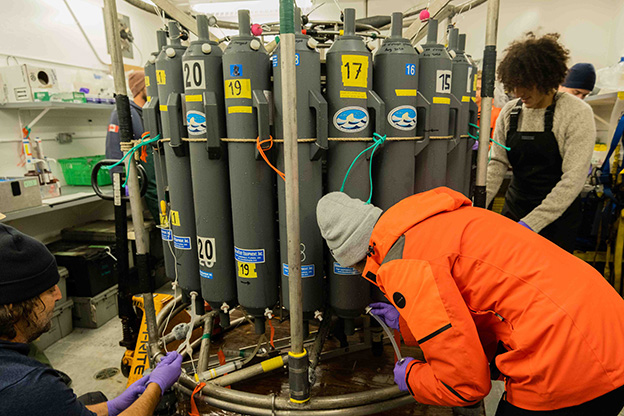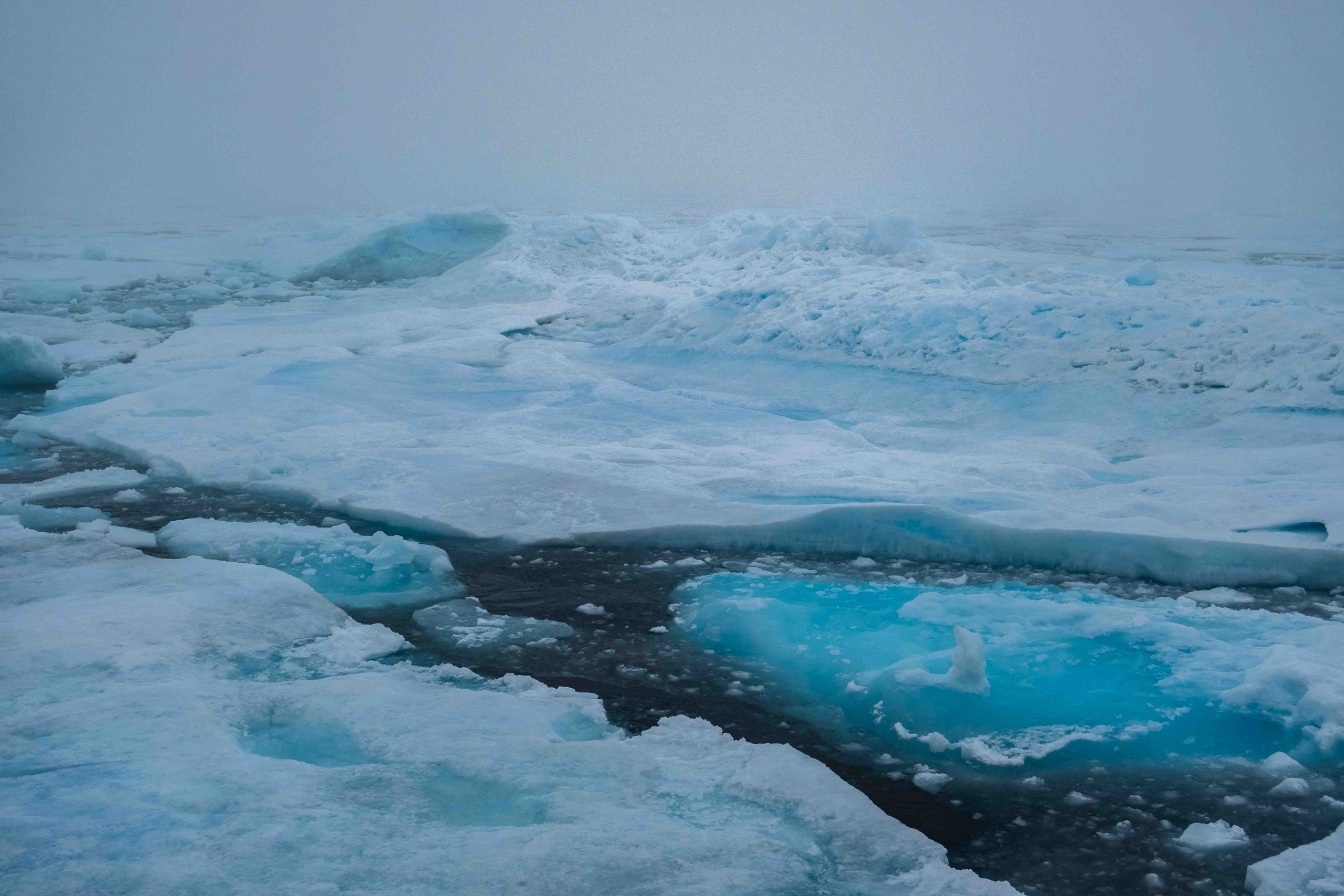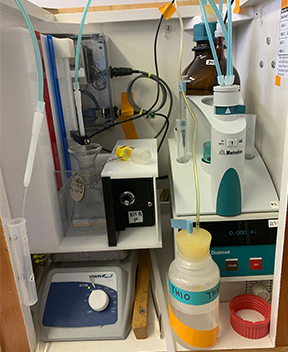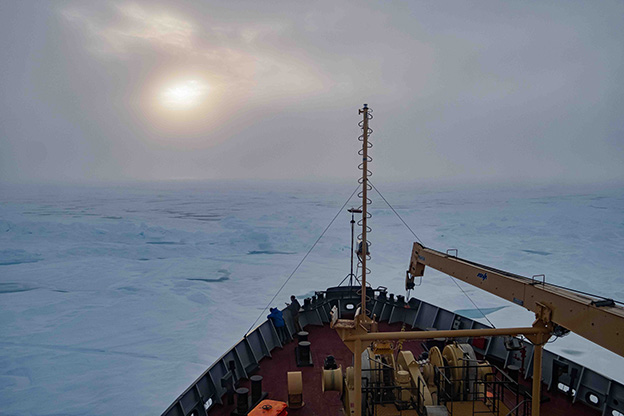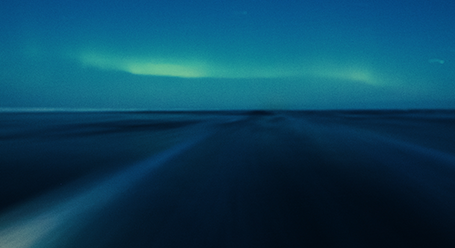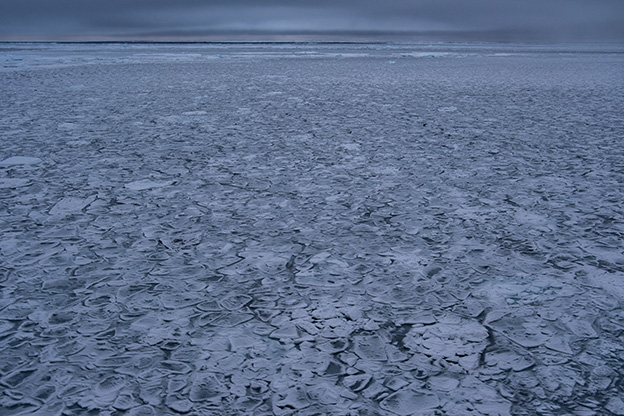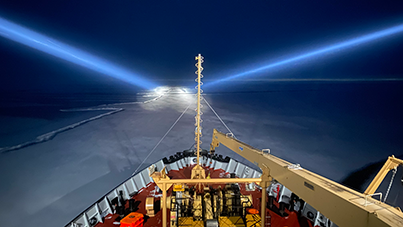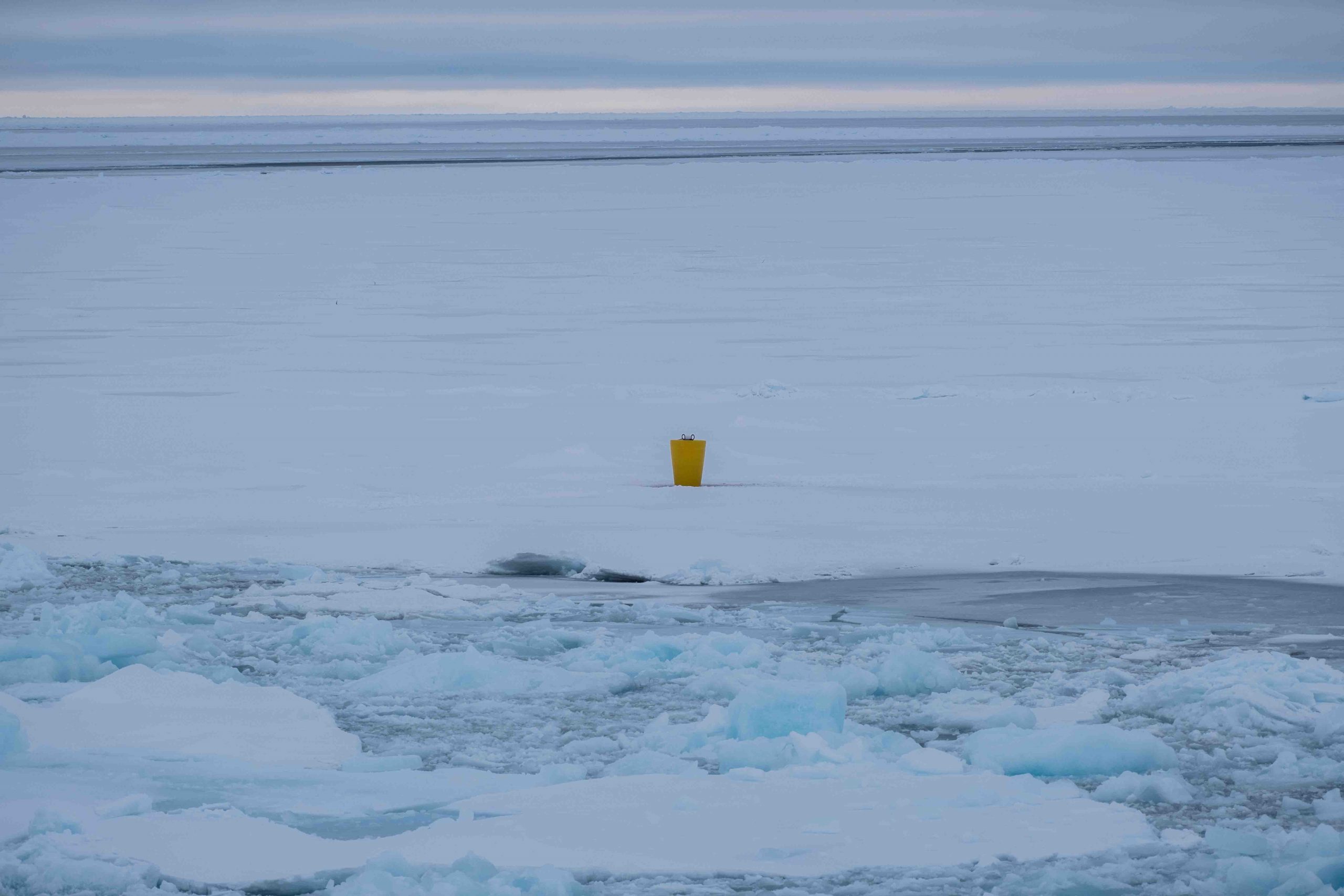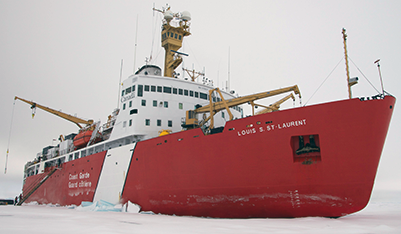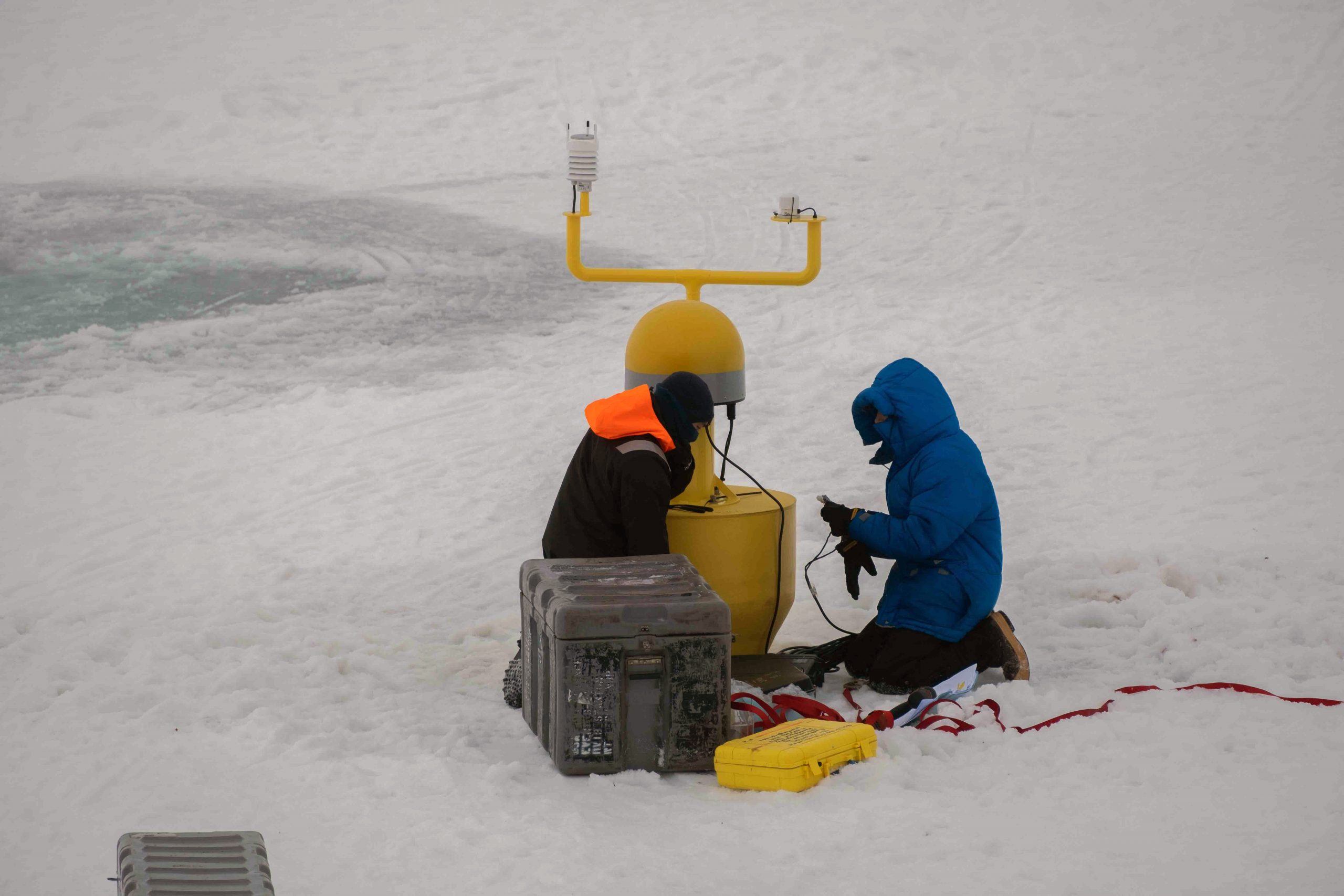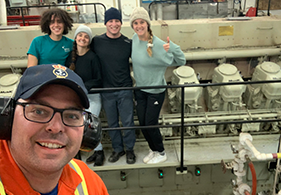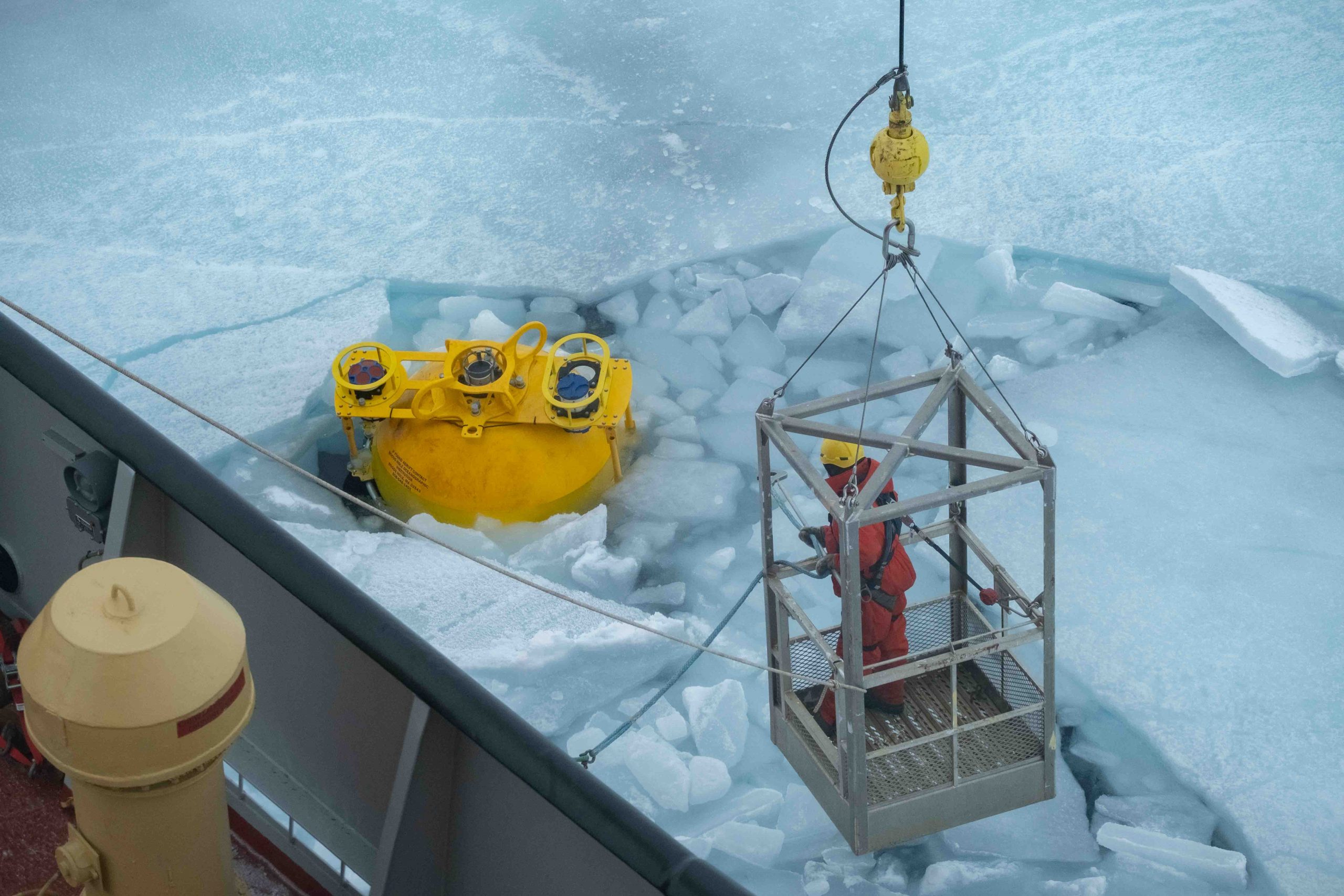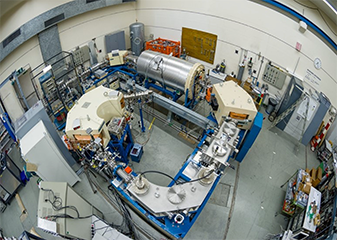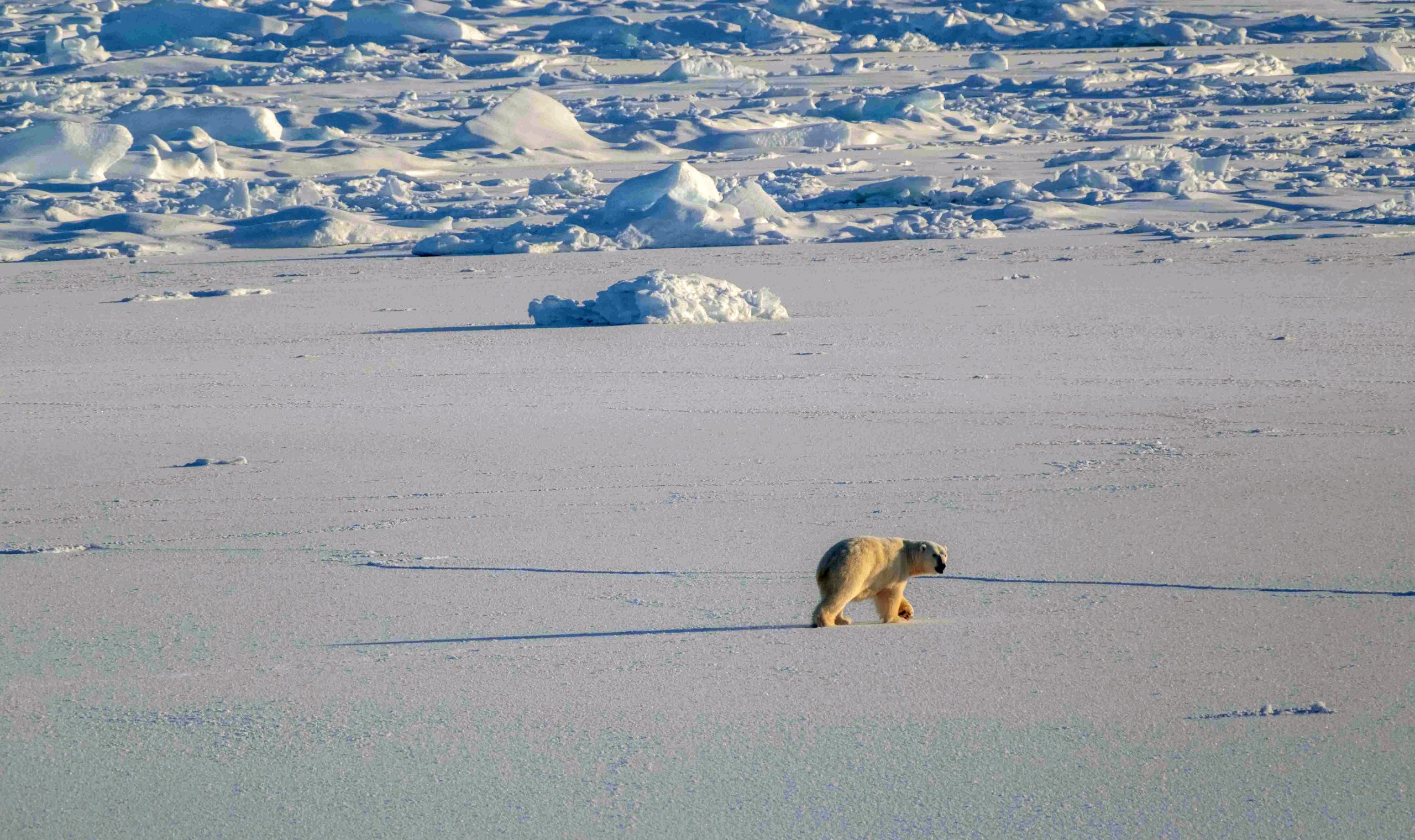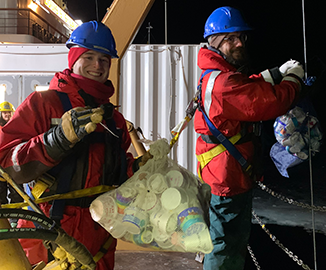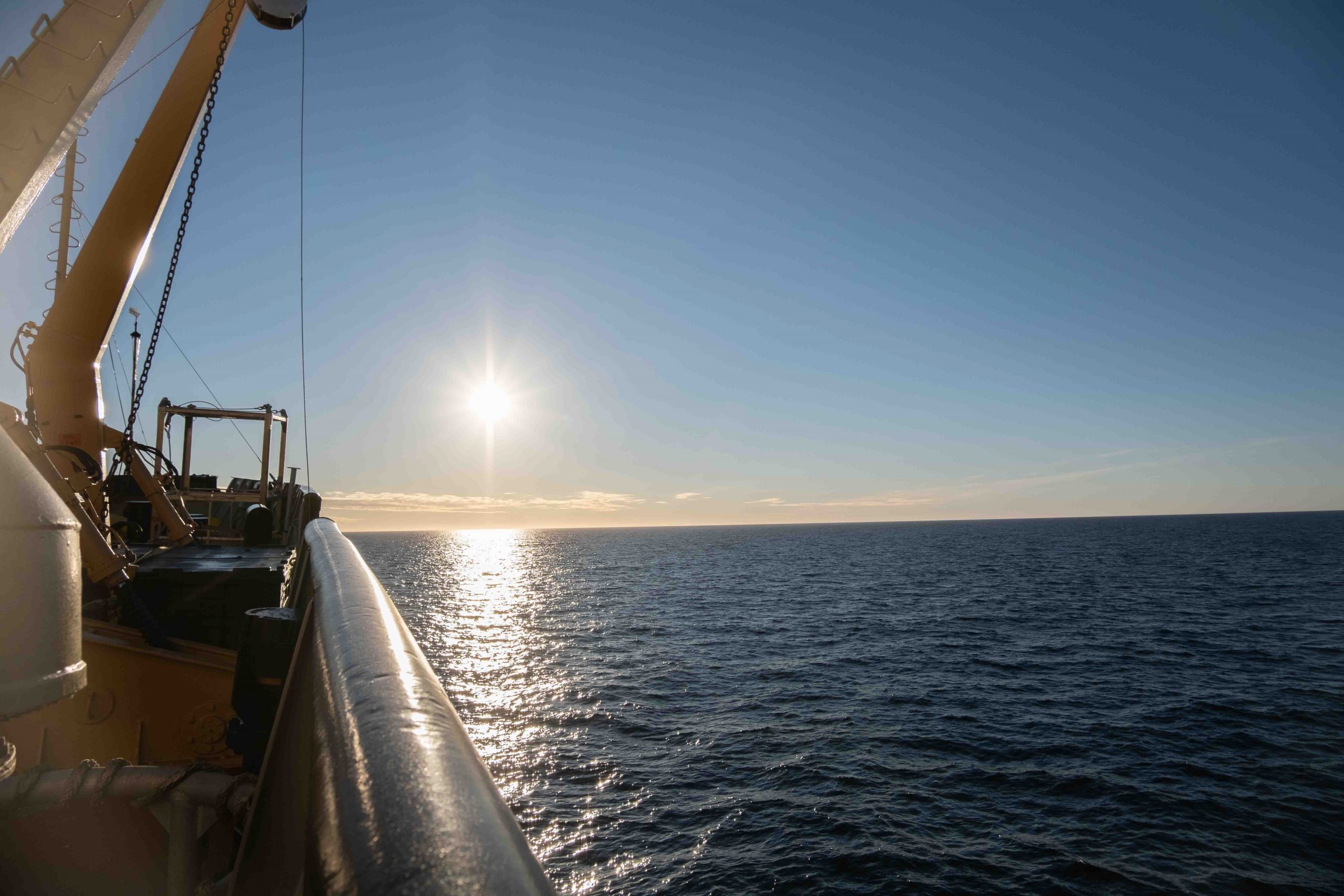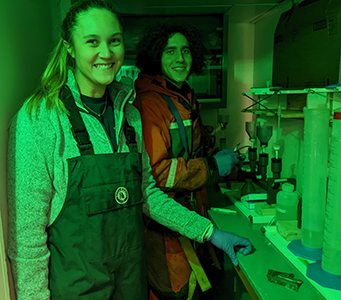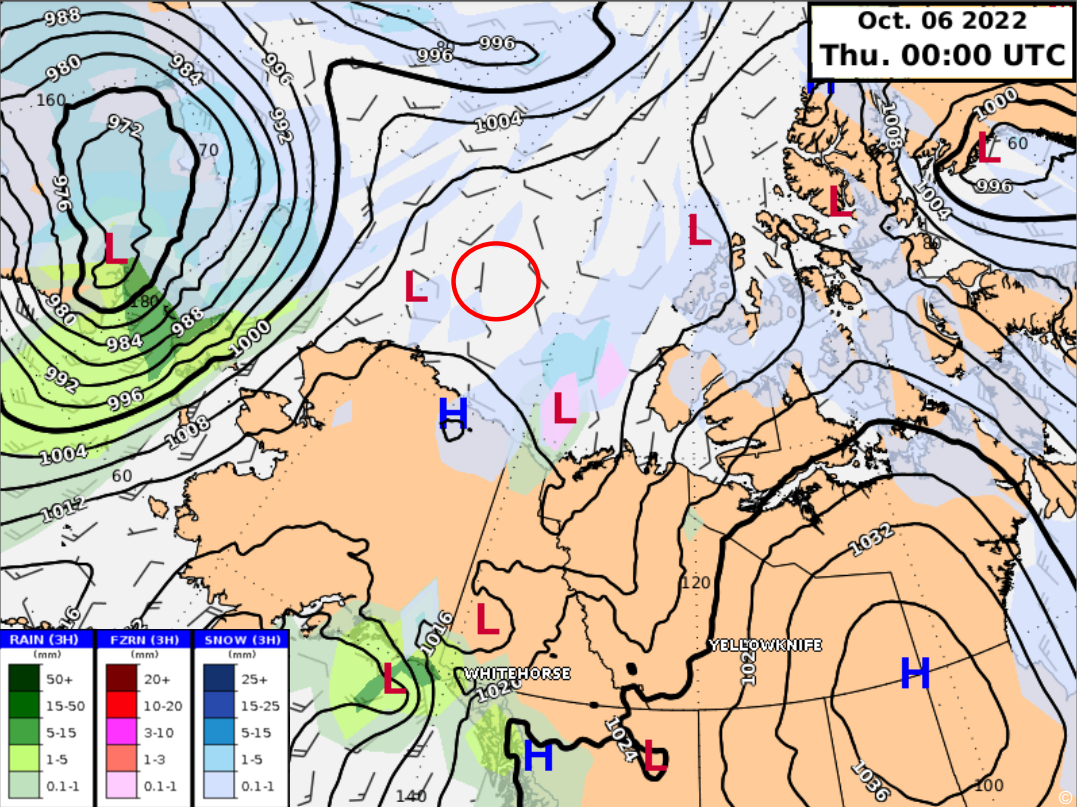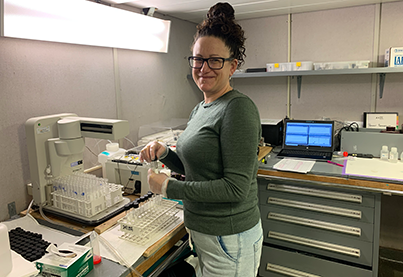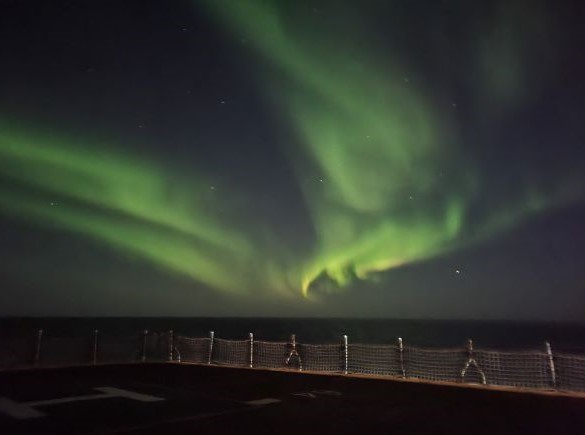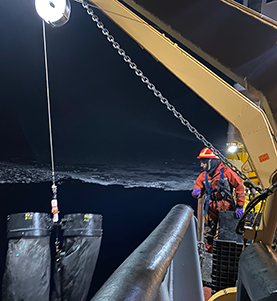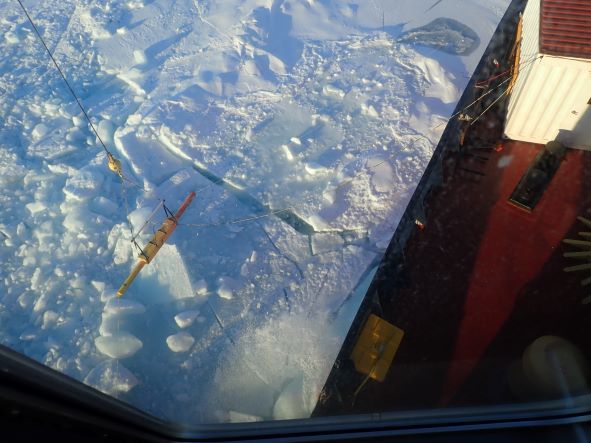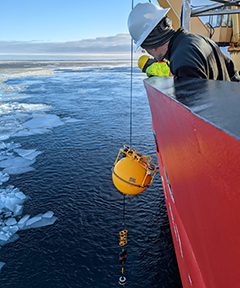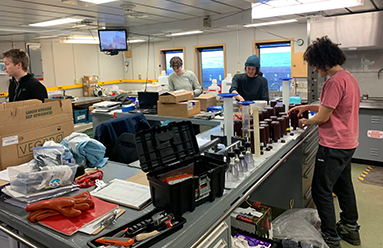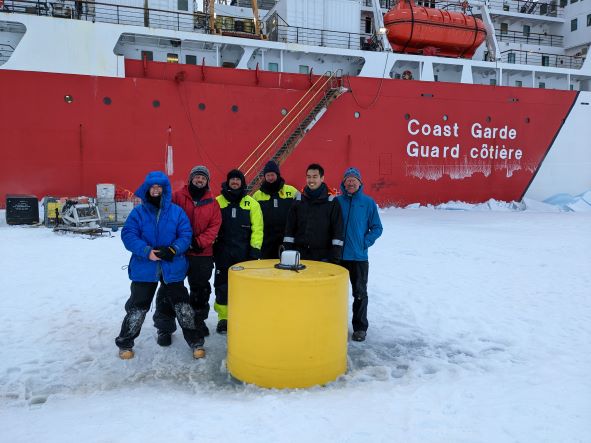2022 Dispatches
Dispatch 1: All Aboard for the 20th Year!
Yesterday was the day we have all been waiting for – the day we boarded the ship! This is Ashley Arroyo and Elizabeth Bailey graduate students from Yale University, and this will be our first expedition on the Canadian Coast Guard Ship Louis S. St-Laurent, our home for the next month. For the duration of the trip, we will be documenting all things Arctic, polar science, life on the icebreaker, and more! Our core science mission is to make measurements and document the changing ocean and sea-ice system, from its physics to chemistry to biology and ecosystems.
Dispatch 2: What is the Beaufort Gyre?
Today, we continue our journey out of the Canadian Archipelago and towards the Beaufort Gyre. In oceanographic terms, a gyre is a circulation system that is driven by the balance between pressure and the effects of Earth’s rotation. The Beaufort Gyre is one of the main ocean circulation systems in the Arctic Ocean. In the Beaufort Gyre, surface currents flow clockwise around the Canadian Basin. Due to the effects of wind and the Earth’s rotation, freshwater collects at the center of the Beaufort Gyre, making it the Arctic Ocean’s major freshwater reservoir.
Dispatch 3: The First CTD Casts!
Last night around 10:00 p.m. EST, we arrived at our first station in Amundsen Gulf, which has historically been the first (or occasionally the last) station for the yearly expedition. In addition, this is a station that has also been sampled by other programs, establishing a long timeseries of valuable data at that location. Since this was our first station of the expedition, it was a perfect time to make sure the oceanographic sensors were operating properly before we start sampling in the Canada Basin. Typically, the station is also used as a training station for the new members of the science team. This year was no different with most of the new members of the science team staying up into the early hours of the morning to complete sampling.
Dispatch 4: We're in the Ice!
Sea ice is one of the main features of the Arctic Ocean. Not to be confused with icebergs (which originate from glaciers on land), sea ice is formed when ocean water freezes. In the wintertime, sea ice covers most, if not all, of the Arctic Ocean. However, the ice extent recedes in the summertime, establishing a seasonal cycle of ice growth in the winter and melt in the summer.
Dispatch 5: Dissolved Oxygen Samples
One of the important quantities that we sample here on the Louis S. St-Laurent is dissolved oxygen! Dissolved oxygen is a valuable water-column property that can provide insight on the biology, pathways, and evolution of the different water masses in the Arctic Ocean. The dissolved oxygen concentrations are originally set when waters are at the surface and exposed to the atmosphere, allowing for air-sea interactions. During atmospheric equilibrium, the dissolved oxygen concentrations depend on the surface water properties, i.e., temperature, and salinity.
Dispatch 6: An Experiment at Sea
In addition to our standard annual measurements of the Beaufort Gyre, this yearly expedition to the Canada Basin also hosts scientists who collect their own samples for research projects including masters theses, Ph.D. research, and more. One of the experiments that is part of the 2022 expedition is being led by Celine Gueguen and her two Ph.D. students, Justin Forget and Nicolas Sylvestre from the Universite de Sherbrooke. Their experiment will be conducted on board for the rest of the cruise! The goal of their project is to analyze the ambient water properties that affect carbon in different water masses (i.e., a particular layer in the ocean that is defined by its temperature and salinity).
Dispatch 7: Water Mass Tracers: Hafnium and Neodymium
How do we know the origins of water masses in the Arctic Ocean? Well, there are several ways to find out. For example, water masses typically have a specific temperature and salinity signal based on their origins. Another way to determine the origin of a particular water mass is to look at its trace elements and isotope compositions. As a part of our expedition, Annabel Payne, a PhD student at ETH Zürich, is collecting water samples to measure two isotopes (Hafnium and Neodymium) to help understand the origin of surface waters in the Canada Basin.
Dispatch 8: Salt, Hacky Sacks, Puzzles, and lots of Pancakes!
Ocean water contains salt, or in other words, it has a salinity. Salinity is an incredibly important property of ocean water as it influences the density of seawater (along with temperature and pressure). Particularly in polar oceans, salinity plays a major role in the vertical structure of density in the water column as changes in density are primarily governed by changes in salinity. In the Arctic Ocean, as you go down in depth, the curves of salinity and density are similar in shape and structure. We make measurements of salinity in a variety of ways.
Dispatch 9: Operating in the Sea-Ice
Navigating the ship through the sea-ice is no easy task! Luckily, there are several tools that are utilized by the captain and mates to help make decisions that make traveling through the ice much easier. Of course, the most efficient way to navigate in this region is to avoid the ice, and sail through areas of open water because the ship experiences less resistance going through water than going through ice. Although once we are in mostly ice-covered waters, the Captain and mates try to look for leads, which are gaps between ice pans. When there are no leads, the Captain and mates use the weight of the ship and the momentum created to smash through the ice.
Dispatch 10: We've Deployed Our First ITP!
Yesterday morning, the team from WHOI (Woods Hole Oceanographic Institution) were the first people to go out onto the ice this expedition! Their role is to facilitate the deployment and recovery of many instruments that will be left out in the Beaufort Gyre to collect data year-round. When the WHOI team went onto the ice yesterday morning, they deployed the first Ice-Tethered Profiler of the cruise.
Dispatch 11: Sampling on the Ice!
Today we have reached another ice station, which means that most of the science team will be on the sea ice helping with various projects. In addition to the deployments of an Ice-Tethered Profiler (ITP), a Top-Ocean Profiler (TOP), ice-mass balance buoy, and an Arctic Ocean Flux buoy, there are several other projects in motion that involve sampling on the sea ice itself! One of the teams on the ice was responsible for taking ice-core samples, which are cylindrical sections of ice that are drilled from the surface to the bottom of the ice/ocean interface. The length of the cores is equal to the thickness of the sea ice that is drilled into to retrieve them, which is usually about 1-2 meters at our stations.
Dispatch 12: TOPs, SIMBBs, AOFBs – Oh My!
During our ice stations, we deployed three other buoys in addition to the Ice-Tethered Profiler (ITP, discussed in dispatch 10) – a Tethered Ocean Profiler, a Seasonal Ice Mass Balance Buoy, and an Arctic Ocean Flux Buoy. All three of these instruments are complimentary to the data collected by the ITP and provide useful data on the upper Arctic Ocean and the sea ice above that is not captured by the ITP.
Dispatch 13: The Engine Room
Despite already having spent two weeks aboard the Louis S. St-Laurent, many of us on the science team have never been down to the engine room to see how the ship is powered! In between stations, a few of us on the night shift jumped on the opportunity to receive a tour of the engine room from Phil Rideout! Before we made the journey down to see the inner workings of the ship, we were warned that we would need earplugs, as it gets super loud down there. With earplugs in, the four of us (Nicolas, Annabel, Nimrod, and I) journeyed down several steep staircases and arrived in the control room of the engine room, where we met up with Phil. From there, Phil gave us the grand tour.
Dispatch 14: We’ve Completed Our First Mooring Station!
An important goal of the expedition (apart from the CTD casts and ice station operations discussed in previous dispatches) is the recovery and deployment of three moorings that make up the Beaufort Gyre Observing System (BGOS). A mooring is a collection of instruments that are tethered to a wire, which is anchored to the sea floor with a float at the top that keeps the wire vertical. Yesterday, the team from WHOI (Jim Ryder, Jeff O’Brien, James Kuo, John Jordan) successfully recovered our first mooring of the expedition. Then today, a new mooring was deployed – maintaining a timeseries of two decades worth of data on the Beaufort Gyre established by these moorings.
Dispatch 15: Dissolved Isotopes
Annabel Payne (PhD student) and Anne-Marie Wefing (postdoc) are from ETH Zürich taking water samples to analyze dissolved isotopes in the Canada Basin while aboard the Louis S. St-Laurent. As you may remember from dispatch 7, one of the sub-projects that Annabel is sampling for involves using Hafnium and Neodymium isotopes to study the origin of surface water in the Canada Basin. In addition to this, there are two other ongoing projects that Annabel and Anne-Marie are collaboratively taking water samples for. Today at the 11:00am science meeting, which is a daily meeting to discuss weather, research, and other updates, Annabel and Anne-Marie gave us a brief presentation of their sub-projects!
Dispatch 16: Life On and Under the Ice
For her role during the expedition, Susie McLatchie is working on maintaining a dataset of DNA that began in 2015. As a master’s student at Concordia University, her research is focused on understanding the species composition and their ecosystem function of a variety of microorganisms (or microbes) that live in the Beaufort Sea. She does this by collecting many samples from the Niskin bottles at some of our CTD/Rosette Stations.
Dispatch 17: Shrinky Cups!
Today, we did our deepest CTD cast of the expedition (3830 meters), which was located at 75°18.00’N 153°18.00’W! As you go deeper in the ocean, the weight of the water above you is heavier, and so the pressure pushing down on you is larger. As you can imagine, there is quite a bit of pressure pushing down on the rosette when it is at a depth of 3830 meters! So, everyone on the Louis continued a long-standing tradition of coloring styrofoam cups and bowls, which would be attached to the CTD rosette, and sent to the bottom of the Arctic Ocean!
Dispatch 18: Cruising along the Coast
This morning the Louis S. St-Laurent left the ice pack for the first time in over two weeks. Why? We will be beginning our coastal water sampling. Tonight, we will tackle the Barrow Line – a series of CTD stations over the continental shelf just west of Utqiagvik (Barrow), Alaska. Along with the Mackenzie Line (which will be the last of our scientific activities), these two transects along the continental shelf are all of the coastal sampling we do. These stations have a wide range in depths, from about 100 to 3000 meters deep!
Dispatch 19: Transparent Exopolymer Particles (TEPs)
Nimrod Rozen is an undergraduate student at the University of Victoria who is taking water samples for his senior research whilst aboard the Louis. Transparent exopolymer particles (TEPs) are gel-like polysaccharides produced by phytoplankton excretions that play a pivotal role in carbon cycling in the ocean. Namely, TEP is responsible for a significant downward flux of particulate organic carbon (POC) through its role as a ‘marine glue’ that binds together aggregates of marine snow.
Dispatch 20: A Storm at Sea!
As of last night, and over the next couple of days, the ship will be feeling the effects of a strong low pressure storm system that is currently just off the west coast of Alaska. The storm is expected to continue towards the coast of Alaska and then move northward into the Beaufort Gyre. Much like this low-pressure system, tropical cyclones (i.e., typhoons and hurricanes) are a type of storm system with a low-pressure center (or eye) with a spiral of thunderstorms. These types of storms rotate counterclockwise in the northern hemisphere and clockwise in the southern hemisphere – an effect of the Earth’s rotation.
Dispatch 21: Nutrients are NUTS!
An important group of chemical parameters that are analyzed onboard the Louis are dissolved inorganic nutrients (i.e., nitrate, phosphate, and silicate). Primary production (the creation of organic material through photosynthesis) requires carbon dioxide, water, sunlight, and inorganic nutrients. Measuring these nutrients throughout the water column gives insight into biological processes and ecosystems in the Arctic Ocean.
Dispatch 22: A Night of Dancing Lights
In the early hours this morning, the deck of the Louis was a popular place to be. Around 11:30 p.m. last night, the first of the Northern Lights began to illuminate the night sky, though they were dim and similar to what we had seen intermittently throughout the expedition. However, a couple of hours later the show truly began as the Aurora brightened significantly and danced across the entire night sky.
Dispatch 23: Marching to the Beat of Our Own Bongo (Nets)
Zooplankton are small animals that reside in the upper water column. Plankton are organisms that cannot effectively swim on their own, so zooplankton are carried along by ocean currents and mixing. Zooplankton range in size; most are too small to see without a microscope, and some are much larger and visible to the naked eye. For example, jellyfish are a type of large zooplankton! Unlike smaller planktic organisms (i.e., phytoplankton), zooplankton cannot produce their own food through photosynthesis, so they tend to consume smaller plankton. Organisms that consume zooplankton include certain species of fish, birds, and whales. Since these small organisms play a critical role in the food web, measurements and analyses of zooplankton are useful in understanding biological communities in the ocean.
Dispatch 24: Ice Ice Baby
Throughout the expedition, sea ice observations have been led by Kazu Tateyama and his student, Kosuke Kawamura, who are from Kitami Institute of Technology (KITMAI). While they led on-ice observations, they are also responsible for ship-based observations made both via camera and with electromagnetic–induction (EM) measurements off the side of the ship. The EM sensor allows for Kazu to collect a timeseries of snow and ice thickness for the entire duration of our scientific operations.
Dispatch 25: Measuring CO2 in the Arctic Ocean
Carbon dioxide (CO2) is an important greenhouse gas, which traps and re-emits heat in the Earth’s atmosphere. The oceans are a significant carbon sink; the amount of CO2 in the Earth’s atmosphere is of comparable magnitude to that absorbed by the ocean. Since colder surface waters can absorb more CO2 than warmer waters, the Arctic Ocean plays an important role in global CO2 uptake. Understanding how CO2 is evolving in the Arctic Ocean is particularly relevant because of sea-ice decline; decreasing sea ice concentrations lead to the potential for increased air-sea gas exchange, which could alter carbon cycling and storage on local and global scales. For these reasons, it is very important to monitor CO2 storage and air-sea fluxes in the Arctic Ocean.
Dispatch 26: Packing Up
Yesterday was our last day of science on the Louis, marked by the last rosette cast at station CB28b, which came back on deck around 4pm. To celebrate another successful expedition, the science and ship crew gathered in the forward lounge in the evening to enjoy food and good company. There were lots of laughs, snacks, and even some karaoke!
Dispatch 27: Goodbye Louis! And Thank You!
After 28 days aboard the Louis S. St-Laurent, we’re all looking forward to disembarking tomorrow and going back home. Overall, it has been an incredibly successful year for this program. With 26 members of the science team and 50 crew including the captain, operations were able to happen 24/7 – aiding in the success of our extensive sample and data collection, as well as instrument deployments.
